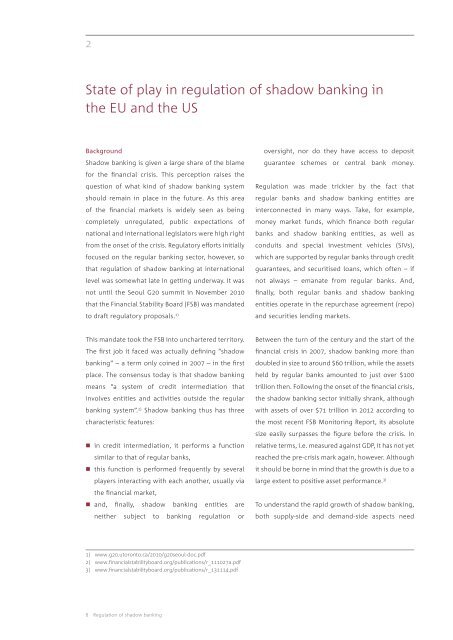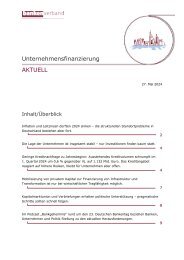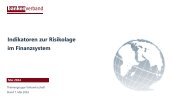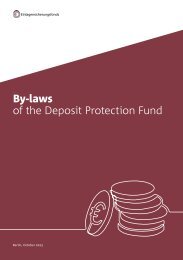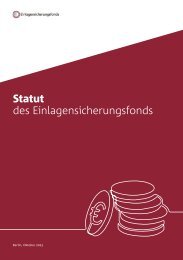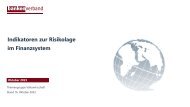Regulation of shadow banking
Shadow banking is given a large share of the blame for the financial crisis. This perception raises the question of what kind of shadow banking system should remain in place in the future.
Shadow banking is given a large share of the blame for the financial crisis. This perception raises the question of what kind of shadow banking system should remain in place in the future.
Create successful ePaper yourself
Turn your PDF publications into a flip-book with our unique Google optimized e-Paper software.
2<br />
State <strong>of</strong> play in regulation <strong>of</strong> <strong>shadow</strong> <strong>banking</strong> in<br />
the EU and the US<br />
Background<br />
Shadow <strong>banking</strong> is given a large share <strong>of</strong> the blame<br />
for the financial crisis. This perception raises the<br />
question <strong>of</strong> what kind <strong>of</strong> <strong>shadow</strong> <strong>banking</strong> system<br />
should remain in place in the future. As this area<br />
<strong>of</strong> the financial markets is widely seen as being<br />
completely unregulated, public expectations <strong>of</strong><br />
national and international legislators were high right<br />
from the onset <strong>of</strong> the crisis. Regulatory efforts initially<br />
focused on the regular <strong>banking</strong> sector, however, so<br />
that regulation <strong>of</strong> <strong>shadow</strong> <strong>banking</strong> at international<br />
level was somewhat late in getting underway. It was<br />
not until the Seoul G20 summit in November 2010<br />
that the Financial Stability Board (FSB) was mandated<br />
to draft regulatory proposals. 1)<br />
oversight, nor do they have access to deposit<br />
guarantee schemes or central bank money.<br />
<strong>Regulation</strong> was made trickier by the fact that<br />
regular banks and <strong>shadow</strong> <strong>banking</strong> entities are<br />
interconnected in many ways. Take, for example,<br />
money market funds, which finance both regular<br />
banks and <strong>shadow</strong> <strong>banking</strong> entities, as well as<br />
conduits and special investment vehicles (SIVs),<br />
which are supported by regular banks through credit<br />
guarantees, and securitised loans, which <strong>of</strong>ten – if<br />
not always – emanate from regular banks. And,<br />
finally, both regular banks and <strong>shadow</strong> <strong>banking</strong><br />
entities operate in the repurchase agreement (repo)<br />
and securities lending markets.<br />
This mandate took the FSB into unchartered territory.<br />
The first job it faced was actually defining “<strong>shadow</strong><br />
<strong>banking</strong>” – a term only coined in 2007 – in the first<br />
place. The consensus today is that <strong>shadow</strong> <strong>banking</strong><br />
means “a system <strong>of</strong> credit intermediation that<br />
involves entities and activities outside the regular<br />
<strong>banking</strong> system”. 2) Shadow <strong>banking</strong> thus has three<br />
characteristic features:<br />
• in credit intermediation, it performs a function<br />
similar to that <strong>of</strong> regular banks,<br />
• this function is performed frequently by several<br />
players interacting with each another, usually via<br />
the financial market,<br />
• and, finally, <strong>shadow</strong> <strong>banking</strong> entities are<br />
neither subject to <strong>banking</strong> regulation or<br />
Between the turn <strong>of</strong> the century and the start <strong>of</strong> the<br />
financial crisis in 2007, <strong>shadow</strong> <strong>banking</strong> more than<br />
doubled in size to around $60 trillion, while the assets<br />
held by regular banks amounted to just over $100<br />
trillion then. Following the onset <strong>of</strong> the financial crisis,<br />
the <strong>shadow</strong> <strong>banking</strong> sector initially shrank, although<br />
with assets <strong>of</strong> over $71 trillion in 2012 according to<br />
the most recent FSB Monitoring Report, its absolute<br />
size easily surpasses the figure before the crisis. In<br />
relative terms, i.e. measured against GDP, it has not yet<br />
reached the pre-crisis mark again, however. Although<br />
it should be borne in mind that the growth is due to a<br />
large extent to positive asset performance. 3)<br />
To understand the rapid growth <strong>of</strong> <strong>shadow</strong> <strong>banking</strong>,<br />
both supply-side and demand-side aspects need<br />
1) www.g20.utoronto.ca/2010/g20seoul-doc.pdf<br />
2) www.financialstabilityboard.org/publications/r_111027a.pdf<br />
3) www.financialstabilityboard.org/publications/r_131114.pdf<br />
8 <strong>Regulation</strong> <strong>of</strong> <strong>shadow</strong> <strong>banking</strong>


